Reviews
How One Obscure David Hockney Painting Encapsulates the Greatness of His Work
The hints of doubt in the artist's paradise are what make the great works last.
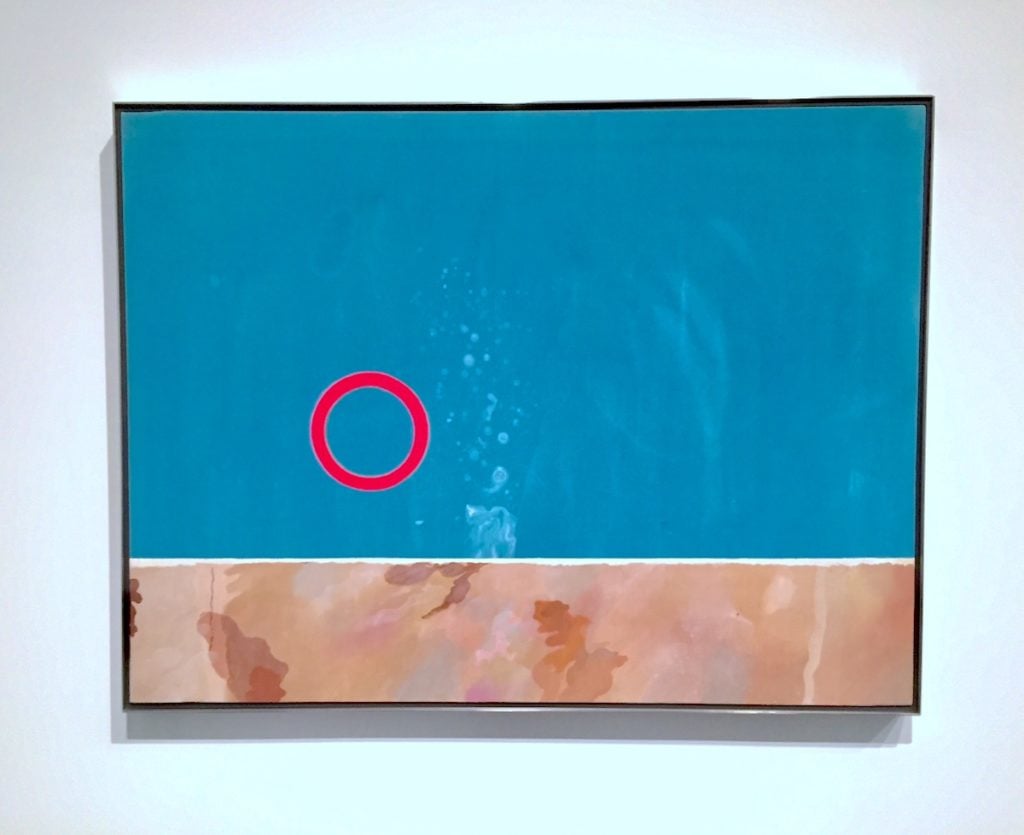
The hints of doubt in the artist's paradise are what make the great works last.

Ben Davis

The Metropolitan Museum of Art’s big, popular David Hockney retrospective is more than worth your time. As far as I can tell, however, what it reveals is that the conventional opinion of the beloved British painter is basically the right one. His most famous works are also his best works, specifically the late-1960s, early-‘70s cycle making of Los Angeles’s artificial oasis an achieved, if slightly remote, paradise of gay desire.
Since that’s not, maybe, the biggest reveal, I will focus on a single work from Hockney’s golden period to try and explain why: Rubber Ring in a Swimming Pool, from 1971.
But first, a word about the later works, for contrast. Hockney is about as famous as an artist can be. He has now for decades occupied a role in the British art narrative, that of the Great Painter, that critics very desperately want to have filled.
When I see his late paintings, that’s what I see. Their subject matter is the serenely mythologized stuff of Great Painting. In this show, you get a lot of landscapes and interiors—or, in some cases, a combination of the two, as in the final series here, rendering the view from the veranda of his LA home in unmixed Matissian blues and greens.
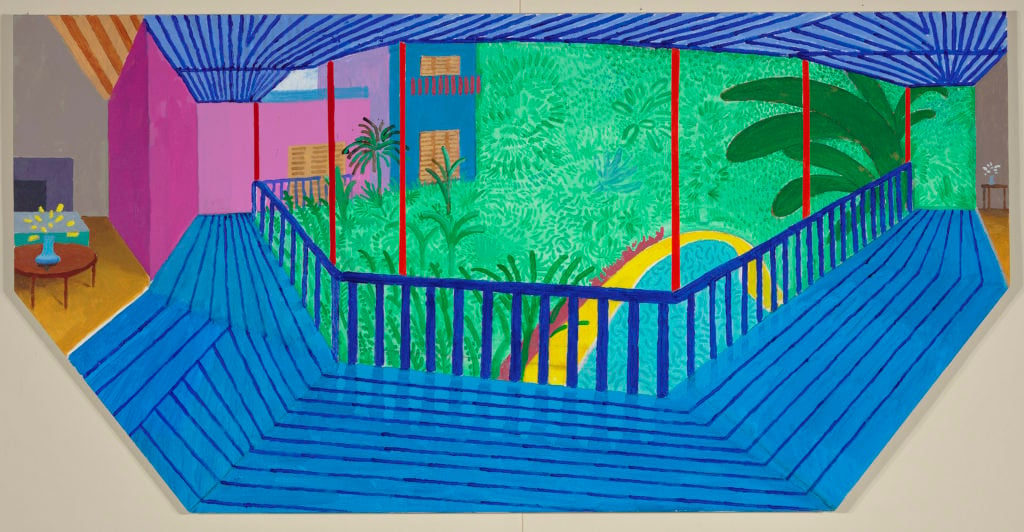
David Hockney, A Bigger Interior with Blue Terrace and Garden (2017).
© David Hockney Photo Credit: Richard Schmidt
Such works emanate, for me, a sated sophistication. For all the pleasures of their breezy virtuosity, what they offer the viewer—a keyed-up form of classic landscape painting without much to mark its present-ness—goes down so easily that it doesn’t particularly stick in the mind.
(I suspect that the fanfare around Hockney’s iPad paintings owes a lot to the relief that they provide by introducing some dynamism into this well-loved but placid vision, if only through the brute force of technological novelty.)
This sensibility contrasts somewhat with the young Hockney, who staked out new symbolic terrain. As a student, he was painting what he himself described as “homosexual propaganda” at a time when homosexuality was still illegal in Britain. Then, when he moved to sunny LA in 1964, he found a city without an established artistic iconography, and plunged eagerly into conjuring one up with his paintbrush.
Those two heretofore buried thematic wellsprings flowed together into something beautiful in his classic California paintings, with their chimerical blue swimming pools and Edenic lawns.
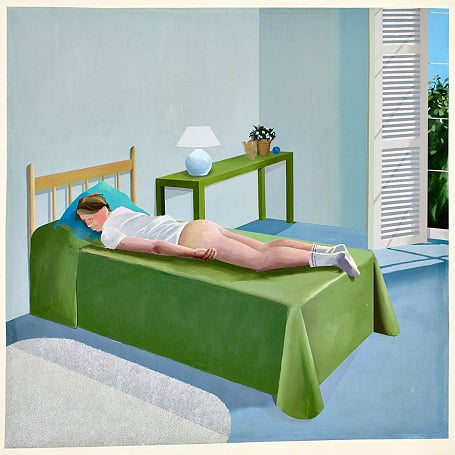
David Hockney, The Room, Tarzana (1967). Image: Ben Davis.
Matisse said he wanted painting to be like “a good armchair which provides relaxation from physical fatigue.” Hockney’s Matisse-indebted recent works are more like a pillowy, overstuffed mattress where you curl up to read a favorite book. But the pleasures of the ’60s–’70s California paintings are more like the crisp, spartan bed in The Room, Tarzana (1967), where a half-naked young man lays, suspicious, languorous, sexually alert.
Hockney’s most famous California painting, A Bigger Splash (1967), depicts a frozen, painterly blossom of water, evidence of an implied cannonball into the unmoved tranquility of a blue pool. It monumentalizes something by definition fleeting. The picture sticks because it conveys a wonderfully concrete image of a perfect moment that is also, knowingly, a little too perfect to be real.
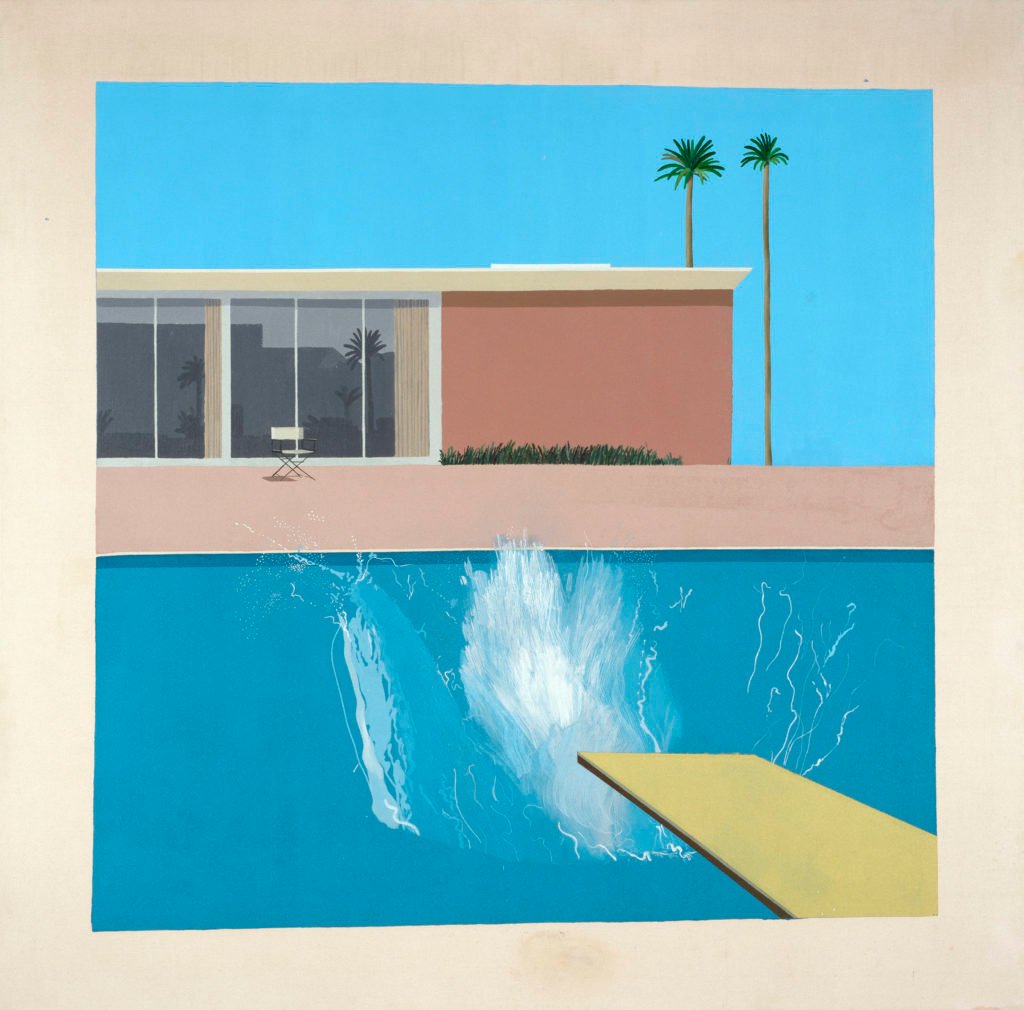
David Hockney, A Bigger Splash (1967). © David Hockney, Photo Credit: © Tate, London 2017
Hockney is credited, in these paintings, with creating an iconography that broke Los Angeles free of noir stereotype. And yes, he gives the people in this world an angelic presence. But I also see a note of Edward Hopper-ish loneliness in their oddly stilted relationships and the aching, ambient emptiness—a hint of darkness in the sun.
Stylistically, the balance between the crisp realism and woozy painterliness in this period of Hockney gives you a world lived in and imbued by real, sensual experiences, but also treated as an apparition. Hockney’s style here makes his scenes seem undecidably eternal and evanescent, hedonistic but tinged with a slight, wistful yearning.
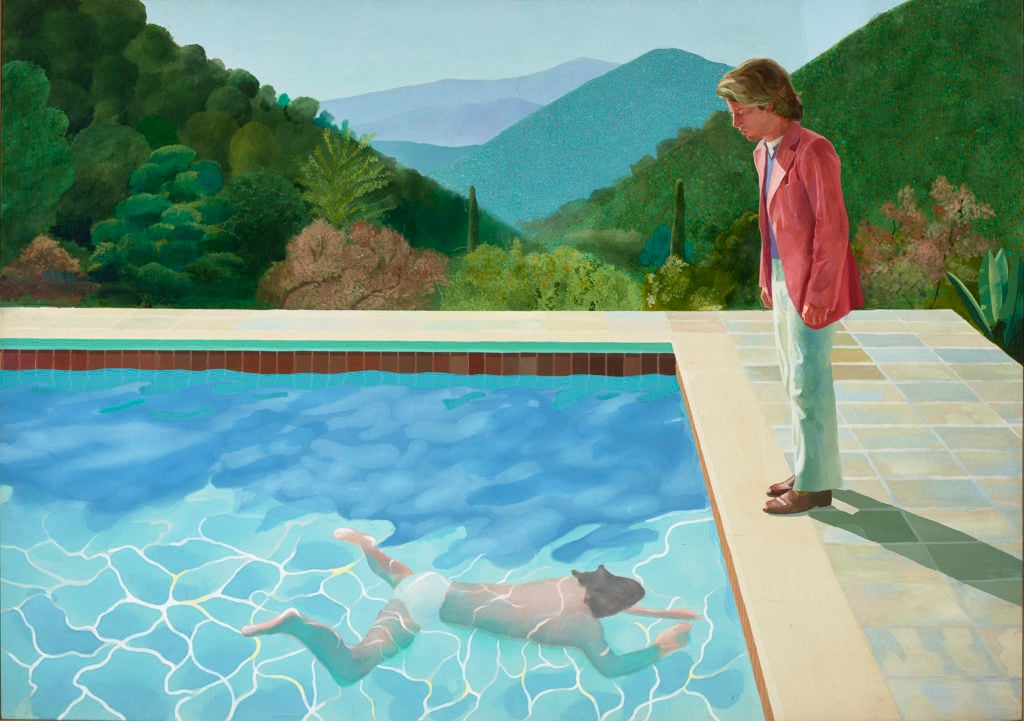
David Hockney, Portrait of an Artist (Pool with Two Figures) (1972).
© David Hockney, Photo Credit: Art Gallery of New South Wales / Jenni Carter
And—this is key—that fact does not contradict the notion that these paintings are firstly about pleasure; it makes their pleasures deeper. In contrast, for me, with the late-career paintings, the California paintings are a masterclass in the difference between contentment and happiness. The former is shallow, associated with distracting oneself. The latter gains strength and intensity from the background awareness of the world’s disappointments; a gin and tonic on the last day of summer.
Which brings me around to Rubber Ring in a Swimming Pool.
It’s a lesser known, smaller, and sparer work, from towards the end of this golden period. There’s a story behind it. It was made as Hockney’s relationship with his long-time lover, Peter Schlesinger, was coming apart. The two had met in 1966, when Schlesinger was an 18-year-old student, and the already-successful expat painter 10 years his senior. That romance was the subject of the 1974 documentary, A Bigger Splash, and was traumatic enough for Hockney that when he first saw that film he went into a catatonic depression.
But you don’t need to know those facts, not really.
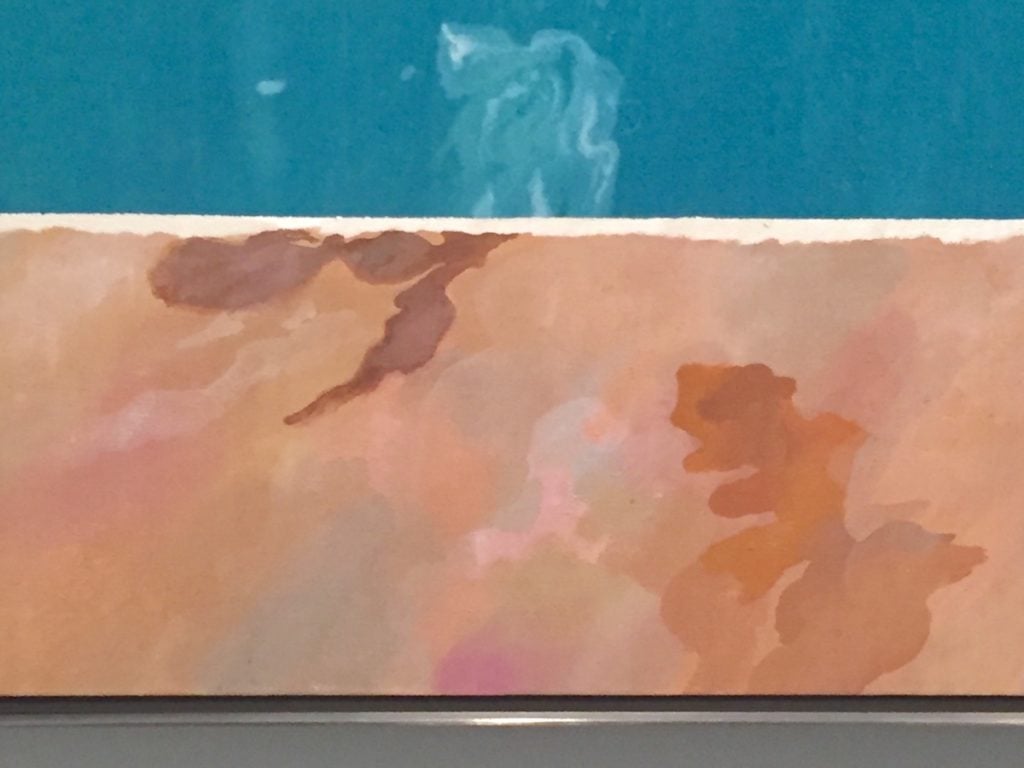
Detail of David Hockney’s Rubber Ring in a Swimming Pool. Image: Ben Davis.
Without being told, you probably see that this is the edge of a pool. At the center, the field of blue acrylic is troubled by a few white swirls, suggesting a jet freshening the chlorinated depths. The dappled brown at the bottom, likewise, deftly invokes the marbling of water-streaked stone. There is an ambiguous white border between the two which is hard to define, maybe a beveled edge of concrete, but that serves to suggest the depth separating the two.
Then there is the key element: the slim red doughnut of the titular pool toy, a rubber ring floating in the water. Given the context, this scarlet torus reads as what it claims to be—but it is a slightly alien presence as well. The painting is based on a photo, but flattened, as if the shape were flush with the surface of the painting, a thing without depth. There is no modeling. Nothing in the blue around it suggests a physical presence in the water.
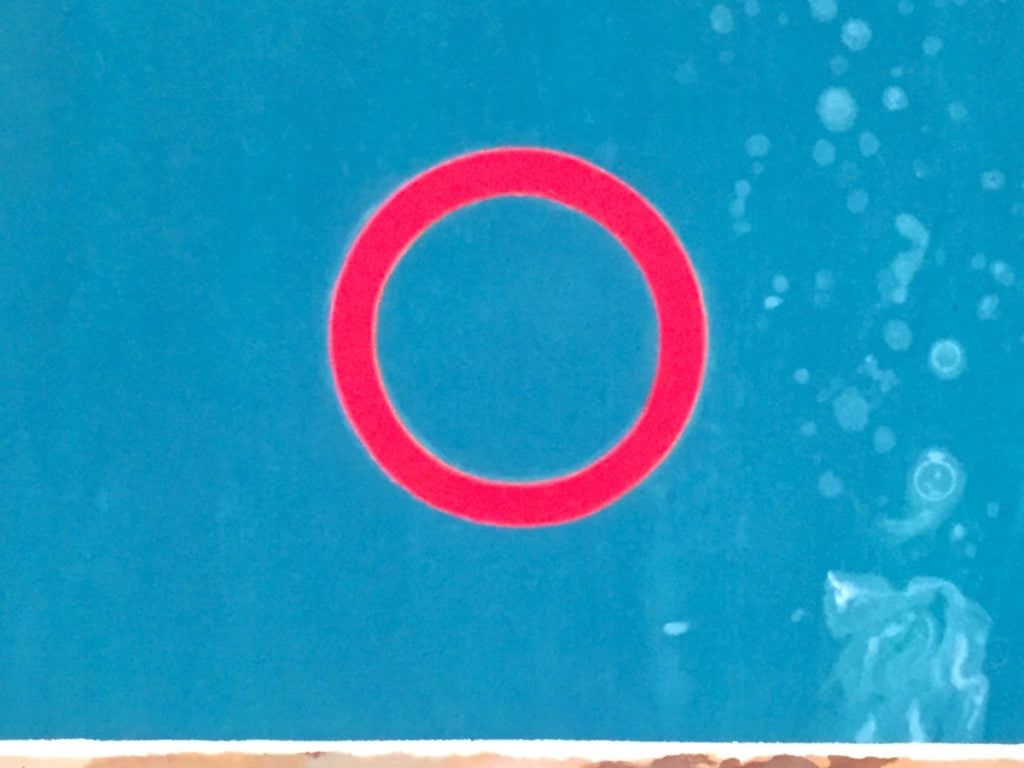
Detail of David Hockney’s Rubber Ring in a Swimming Pool. Image: Ben Davis.
I’ve read that Rubber Ring in a Swimming Pool’s hovering geometry is a joke on abstract art, an Easter egg for painting nerds, which is exactly the kind of hermetic thing I don’t think is that interesting.
But the abstract flourish can be read as serving a purpose. The painting is presented from the point of view of someone staring down into the water. Its sense of stasis reminds me of the pool scene in The Graduate, where the young Benjamin Braddock floats, castaway in his ennui (that film came out, incidentally, in 1967, the same year Hockney painted A Bigger Splash). In Rubber Ring in a Swimming Pool, Hockney’s aqueous, sun-kissed world has become an image stared into so intensely that disassociation has set in. The reality of it has started to drain away.
The red presence floats like a warning symbol in this landscape of desire; in the picture, but not quite in the scene it depicts. In its off-ness, here, it signals how precious the balance of vulnerability and bravado was that made Hockney’s best work, for me, his best work.
“David Hockney” is on view at the Metropolitan Museum of Art, 1000 5th Avenue, New York, November 17, 2017–February 25, 2018.